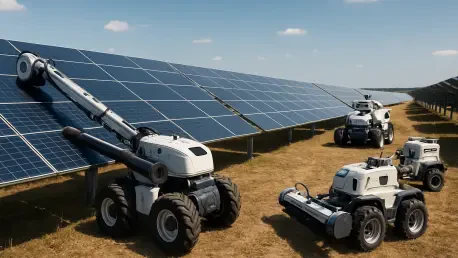In a world increasingly reliant on renewable energy to combat climate change, the construction of solar farms has become a critical endeavor, yet it remains fraught with challenges like labor shortages, safety risks, and tight deadlines that often hinder progress. Traditionally, building these vast arrays of solar panels has been a labor-intensive process, requiring workers to manually position and secure heavy modules under often grueling conditions. However, a groundbreaking shift is underway as robotic technology steps in to transform this landscape. At the forefront of this innovation are AI-powered systems that promise to streamline operations, reduce costs, and enhance safety. A prime example can be seen in projects like the Goorambat East Solar Farm in Victoria, Australia, where automation is not just a concept but a reality driving efficiency. This development signals a new era for the renewable energy sector, where machines and human expertise combine to accelerate the transition to sustainable power sources, setting a precedent for future infrastructure projects globally.
Harnessing AI for Faster, Safer Installations
The integration of robotic systems, such as the LUMI solar robots developed by Luminous Robotics, marks a significant leap forward in utility-scale solar farm construction. These autonomous machines are designed to handle the repetitive and physically demanding task of positioning solar modules onto racking structures with precision and speed. By taking on such labor-intensive work, robots allow human workers to focus on more complex tasks like final securing and quality checks, thereby reducing the risk of injuries associated with handling heavy equipment. Beyond safety, the efficiency of these systems is striking—projects employing robotics are often completed ahead of schedule, as seen in recent deployments where installation timelines have been notably shortened. This not only cuts down on labor costs but also enables faster delivery of clean energy to communities. Supported by substantial funding initiatives, such as grants from programs aimed at scaling up solar technology, these innovations are proving that automation can address longstanding challenges in the industry.
Paving the Way for a Scalable Renewable Future
Looking back, the adoption of robotics in solar farm construction, exemplified by initiatives at sites like Goorambat East, demonstrated a turning point for renewable energy infrastructure. These projects showed that automation could power through barriers like harsh environmental conditions and labor scarcity, particularly in remote or extreme climates where human work was often hindered. The success of such technology also highlighted an unexpected benefit: the upskilling of the workforce. Operating advanced robotic systems required trained technicians, which opened up new job roles and enhanced overall productivity. As a next step, stakeholders in the renewable sector should focus on refining these technologies to further optimize performance and adaptability across diverse terrains. Continued investment in research and broader implementation will be crucial to ensure that the benefits of reduced costs and improved safety reach more projects. Ultimately, this robotic revolution laid the groundwork for making solar energy more accessible and affordable, shaping a sustainable path forward for generations.









